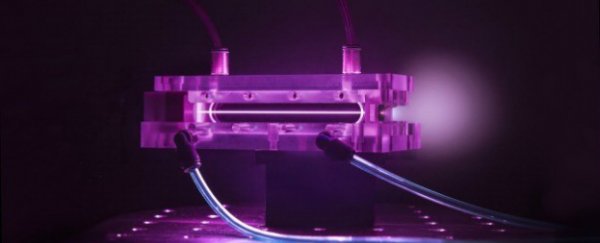Using one of the most powerful lasers in the world, researchers in the US have accelerated electrons to the highest energies ever recorded from a compact accelerator.
The team from Lawrence Berkeley National Laboratory in the US has managed to speed subatomic particles to an energy of 4.25 giga-electron volts inside a 9-cm-long tube of plasma.
Over such a small distance, this represents 1,000 times greater acceleration than traditional particle accelerators, including the 27-km-long Large Hadron Collider (LHC) at CERN, and marks a world record energy for laser-plasma accelerators.
Because subatomic particles zoom around accelerators so quickly, they're measured by the amount of energy they gain rather than a kilometres per hour measurement. In comparison, the LHC can achieve maximum energy gains of around 100 mega-electron volts per metre.
It's important to note that obviously devices such as the LHC can achieve higher energies overall, but across such a small space, this tiny tabletop-sized accelerator is superior.
Published in Physical Review Letters, the results were achieved using a new breed of particle accelerator, known as laser-plasma accelerators.
These accelerators rely on lasers and plasma - a charged-particle gas - to speed up subatomic particles extremely rapidly. Traditional particle accelerators instead speed up electrons inside a metal vacuum using changing electromagnetic fields.
"This result requires exquisite control over the laser and the plasma," said Wim Leemans, lead author of the paper, in a press release.
The laser in this case was called BELLA (Berkeley Lab Laser Accelerator) and it's one of the most powerful lasers in the world, capable of producing a quadrillion watts of power (a petawatt).
Their "tunnel" was a 9-cm-long tube of plasma, and the system relies on a type of acceleration first propose in the '70s, known as plasma wakefield acceleration.
"In the case of this experiment, a pulse of laser light is injected into a short and thin straw-like tube that contains plasma. The laser creates a channel through the plasma as well as waves that trap free electrons and accelerate them to high energies. It's similar to the way that a surfer gains speed when skimming down the face of a wave."
A computer simulation of the plasma wakefield over the 9-cm-long tube is below.

Because they're working with such high energies, the researchers used computer simulations to test the set up before they ever turned on the laser.
Small changes in the setup give you big perturbations," said Eric Esarey, who led the theoretical side of the project, in the release. "We're homing in on the regions of operation and the best ways to control the accelerator."
The team now hopes to achieve energies of 10 giga-electron volts with their accelerator. In order to do this, they will need to more precisely control the density of the plasma channel through with the laser beam flows. In theory, they need to create a tunnel for the light pulse that's the right shape to handle more-energetic electrons.
But for now, they've proved that condense laser-plasma accelerators definitely have the potential to conduct scientific experiments that currently require far larger machines.
"It is an extraordinary achievement for Dr. Leemans and his team to produce this record-breaking result in their first operational campaign with BELLA," said James Symons, a physicist at Berkeley who didn't work on the project, in the release.
